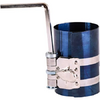case310350
Well-Known Member
I normally have the shop rebuild cylinders, but now they want 500-850 to rebuild, doe not include the kit.
So doing myself.
Now I repacked the cylinder, but ripped the seal on the piston while putting back in the cylinder. The seal is not split, its one piece and sticks out beyond the piston profile. .
Looking for advice, or tricks to get it back in. right now I have a hose clamp on it, will leave over night.
So doing myself.
Now I repacked the cylinder, but ripped the seal on the piston while putting back in the cylinder. The seal is not split, its one piece and sticks out beyond the piston profile. .
Looking for advice, or tricks to get it back in. right now I have a hose clamp on it, will leave over night.

